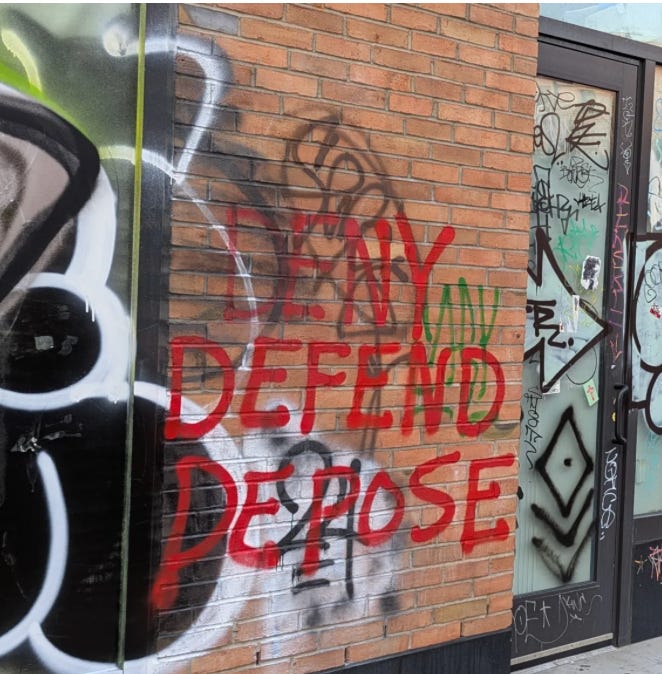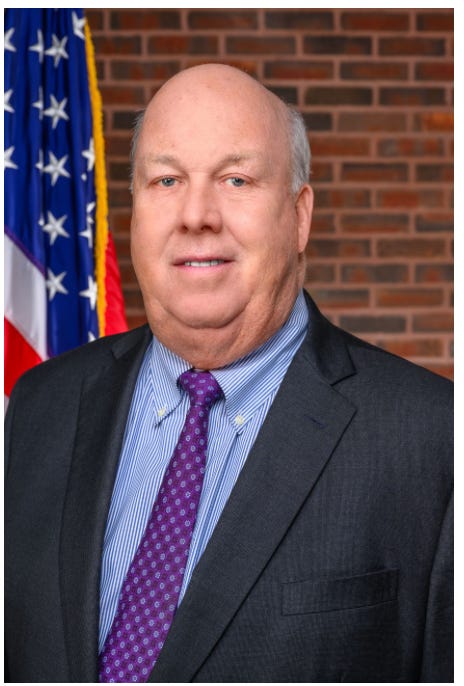The Street as Stage
Why a targeted killing could not have become a political reckoning in Whistling Pines
Note: I want to make clear that I do not condone or admire the actions of the December 4th gunman. You will see me making connections to ideas about political movements that I do, in fact, approve of, but please don’t mistake that analysis for approval for the murder of Brian Thompson.
Also, I refer here to “the gunman” instead of Luigi Mangione out of respect for the principle of the presumption of innocence.
Maple Grove, Minnesota is a suburb about twenty minutes northwest of the Twin Cities. It’s one of those suburbs that was farmland one day and a “planned community” the next, except in this case it was quarries not farms that were erased in order to make room for tract homes.
Its retail district consists of a“simulacrum of a traditional American Main Street designed in neotraditional style” set between vast parking lots and real estate with Dave & Busters energy (and a Dave & Busters).
I dread driving to Maple Grove, about twenty minutes from my home, because any time I’m there, I get lost in the grid of similarly named residential streets lined by homes that are almost indistinguishable from one another. It is, essentially, a city of subdivisions and HOAs.
Whistling Pines is one of those communities (not to be confused with nearby Hemlock Pines and certainly not with Shady Pines). It is a one-road “neighborhood” built by developers and consisting of twenty-six homes, most valued between $1.2 and $1.8 million. HOA fees are reasonable, all things considered, at $181 a month. (Here’s a video featuring a Whistling Pine home—the soundtrack may give you an idea of how realtors see this particular enclave).
At this point, you’d be forgiven for wondering why the hell I’m talking about a luxury housing development in Maple Grove. Or, if you’ve followed the Mangione case long enough to know why Maple Grove is of interest in terms of the facts of the case, you know why it’s come up, but not why I am writing a piece about it.
Well, the post isn’t really about Whistling Pines, which is where UnitedHealthcare CEO Brian Thompson lived, as did his estranged wife, Paulette, from whom he’d been separated at the time of his death. (They lived in separate homes). Nor is it about anything that happened there. I’m more interested in what didn’t happen at Whistling Pines.
There is a healthcare CEO who lives a few miles from me. I only learned of his existence when I was visiting my parents, who live a block or so away from Lake Minnetonka. In this area, a block means the difference between a fairly modest home and one that costs five to six million dollars. Being close enough to purify oneself daily in the waters of Lake Minnetonka1 on the regular is, apparently, worth it.
Anyway, around January, I started to see a black Escalade idling outside one of these lakeside monstrosities. I visited my parents on various days of the week, at various times of the day or night. The person in the driver’s seat might change—they all looked like assets from the Bourne Identity—but the Escalade was always there, 24/7. It became clear that the Escalade was a security measure for some very important person living in the house.
After sending my mom on a mission to gather neighborhood gossip, I learned the man who’d hired the 24/7 security was the CEO of a minor healthcare-adjacent company. Perhaps he’d received some threats and was nervous. (The Escalade eventually disappeared.)
Brian Thompson was not this sort of healthcare CEO. Though he, too, had been on the receiving end of threats, according to his ex-wife, he had never taken measures to protect himself the way our lakeside lion had. Instead, he lived in a suburb, in a non-gated community, his children attended public schools, and according to one of the kids’ lacrosse coaches, Brian and Paulette Thompson “were present around all of the team events.”
I’m not here to tell you this all makes Brian Thompson a good guy or a bad guy. While we can certainly judge him by his acts and deeds in his various leadership positions at UnitedHealthcare, which indisputably caused suffering and harm, none of us can know the private Brian Thompson, the contours of his family life, and his personal joys and struggles.
I’m only drawing your attention to the way Brian Thompson lived his life—relatively modestly and out in the open—to underscore how much easier it would have been for the gunman, logistically, to murder Thompson in Minnesota. No security gate at Whispering Pines. No gatehouse. No roaming private security. No Escalade parked out front.
We may never know if the gunman considered traveling to Minnesota to kill Thompson. What I feel fairly comfortable stating, however, is that the gunman carefully crafted a set piece; and the most salient and consequential aspect of the set piece was the location in which the act unfolded.
Manhattan. On a weekday. Rush hour. Broad daylight. As Thompson was walking to a Unitedhealthcare shareholders meeting—where he was set to announce record profits.
Based on the amount of planning this crime would have required, along with the messages etched into the bullet casings, I’d argue that the gunman understood that the location of the crime mattered more than perhaps any other aspect of the murder.
In Maple Grove, Minnesota, the crime could have been neatly contained, absorbed into private grief rather than a prolonged public reckoning. The proximity to Thompson’s home would’ve given rise to theories of a personal connection, a disgruntled employee from UHC’s Minnetonka, MN campus, a love triangle gone-wrong.
On the streets of New York City, a movement could be born. It’s a stage. While private violence can be fleeting or even invisible, public violence forces engagement. This “reckoning” or “norms enforcement” took place where it did not just for optics sake, but in order that it be seen, unmistakably, as a political act.
Movements Need Mythmaking
Movements and ideologies often, if not always, use location as a way to shape their narratives. Why did the deaths of a few men on a Boston street become a rallying cry for revolution? Why was Caesar killed not at home but in the Senate? Movements need mythmaking. They thrive on narrative. And the quiet narratives of the modern novel or the Merchant-Ivory films (god, am I dating myself here?) won’t do it. Political narrative needs spectacle.
Spectacle and violence are the only two languages power, politics, and money understand. I think it’s possible the gunman who murdered Brian Thompson understood that where something happens dictates how it is received, and how it is remembered.
The Extended Stage
As you know, the spectacle that unfolded on December 4th, 2024, didn’t end with those gunshots. The week-long manhunt for the killer enlarged the set to include the whole of Manhattan. The performance was ongoing. The city provided innumerable escape routes, as opposed to the one road in and out of Whistling Pines. The city offered plenty of opportunities for further statements, such as Central Park, where a backpack containing Monopoly money was found and connected to the gunman.
NYPD press conferences themselves became eye-rollingly theatrical thanks to Mayor Eric Adams. Somehow I don’t think the Mayor of Maple Grove, Minnesota, Mark Steffenson, would have gotten as many sound bites.
New Yorkers, often necessarily desensitized to violence, became emotionally invested in the gunman’s escape. The city, and later the nation, became an active audience. When a photograph emerged of the alleged gunman talking to a clerk at an Upper Manhattan hostel, mask off, the narrative had its protagonist and it was Run, Forrest, Run!
In this way, the act grew to almost mythic proportions—as seen by the national conversations on social media surrounding the inequities and cruelties of America’s healthcare insurance industry, and which revealed experiences and stakes people from wildly different political persuasions shared. Graffiti began appearing in cities not just across the country, but across the world even before Luigi Mangione was identified by NYPD as their suspect.

(Interestingly, the victim, Brian Thompson, almost immediately transformed from man to symbol.)
In Whistling Pines, the gunman would’ve disappeared between McMansions unobserved, a ghost, and local cops would’ve turned up like they would any 911 call about a shooting. To put too fine a point on it, because why not, no chorus in Whistling Pines, and therefore no myth.
The Absolute Necessity of Longevity
All of us are aware of the distressing time dimensions of our news cycle. I realized the other day that I had almost forgotten about Hurricane Helene, for example. The Trump Administration’s Signal disaster is already fading away. This crime, however, was designed to be remembered. That’s because, I suspect, the gunman understood the longevity of public engagement was a necessary element to any hope of substantial change.
If you’re familiar with news cycles, then you know that six days of nonstop media coverage is like an ice age’s worth of time. But coverage was longer than that, and broader than just the murder. The fascinating social response to the killing so confounded, and terrified, the ruling class and the media it controls that the conversation went on even longer than it might have anyway. If the gunman had wanted to wake people up and get them talking, he was more successful than I think even he would have imagined he could be.
So there’s intentionality here (one can argue), and not just to punish a health insurance CEO or even an industry, but to create a rupture in the visual and moral order of the oligarchy.
My last point above, about intentionality, leads to the question of whether the gunman had taken into consideration all the things discussed here. Let’s go speculative for a moment. If we accept that the gunman chose Manhattan over Minnesota because of its symbolic power (Wall Street, shareholder capitalism and the shareholder meeting itself, etc.) then don’t we also have to consider the possibility that the manhunt as a planned second act? A second act that prolonged the conversation about the health insurance industry?
There has been much criticism and handwringing over how ham-handed the gunman’s escape was. Yet, he successfully eluded authorities in one of the most surveilled cities in the world, when his image had been blasted out to Americans pretty much nonstop. For six days.
This delay created space for the public to commiserate about disturbingly common experiences with health insurers, for the press to begin paying attention to those conversations and examining the system the gunman appeared to be indicting.
The Spectacle of the State’s Response
In traditional guerrilla movements, the spectacle is less the attack and more the state’s response. And in the case of the murder of Brian Thompson, the state has produced more spectacle than anything we saw on December 4th. I won’t list everything here, but the Superman-style perp-walk; the corporate media’s frantic attempts to shame the public into mourning for a CEO; the DOJ’s rushed decision to work with New York to add terrorism up-charges (which group was being terrorized, exactly?) and make this a death penalty case because of pressure from industry executives, Eric Adams’ and NYPD brass’s participation in an HBO documentary in which they shared “evidence” they hadn’t even turned over to the defense in discovery, and AG Pamela Bondi’s splashy Instagram announcement confirming they would be seeking the death penalty.

The public watched this spectacle unfold, watched the massive resources roll into the city, the CEOs beefing up their security, and industry leaders leaning on the DOJ, and saw the very themes of corporate impunity and the state’s willingness to mobilize only when power is threatened.
It’s as if a trap had been perfectly laid, and the state walked right into it.
Whistling Pines is a nice place, but it’s no place for mythmaking. The gunman knew he needed a setting where “police believe this was an isolated incident” wouldn’t be possible. Where those bullet casings and the messages they sent wouldn’t be kept secret by a police force, but would be leaked to one of the largest, brashest, and most ruling-class friendly tabloids in the world. A setting where people could spray paint, wheat paste, and create street art that would be seen by millions of people.
In choosing the stage, the gunman chose the story, and ensured the state would help him tell it.
If you know a Minnesotan, you’re not at all surprised by the Prince reference. We work it in to almost anything.







Thought-provoking piece! I'm assuming you've seen this development: https://www.nbcnews.com/business/business-news/unitedhealthcare-sued-shareholders-reaction-ceos-killing-rcna205550.
This line...."The group, which seeks unspecified damages, argues that the public backlash prevented the company from pursuing 'the aggressive, anti-consumer tactics that it would need to achieve' its earnings goals." Wow....someone actually put that in a legal document? Read the room shareholders.....
With her years of experience working in the SDNY and the contacts I'm assuming she still has, I wonder if KFA knew about this upcoming litigation and that's why she included the quote about "the immoral and murderous healthcare industry that continues to terrorize the American people" in her statement regarding the death penalty directive. Of course, even without the UHC lawsuit, Americans are indeed terrorized daily by the insurance industry...
Yes indeed::prevented the company from pursuing the aggressive anti-consumer tactics" as if killing peeps sorry, "denying coverage" via spreadsheet is not enough to enhance "shareholder value."
Some history: United's Optum wanted to merge with Change and was blocked by DOJ: https://www.thebignewsletter.com/p/the-busy-bees-at-the-antitrust-division
DOJ was not successful and Change suffered an enormous cyberattack in 2023 which led to another DOK investigation.
From Snopes:
UnitedHealth was aware of the DOJ investigation since at least October 2023. Instead of disclosing this material investigation to investors or the public, UnitedHealth insiders sold more than $120 million of their personally held UnitedHealth shares. In the four months between learning about the DOJ investigation and the investigation becoming public, UnitedHealth's Chairman Stephen Hemsley sold over $102 million of his personally held UnitedHealth shares and Brian Thompson, the CEO of UnitedHealthcare, sold over $15 million of his personally held UnitedHealth shares.
https://www.snopes.com/fact-check/unitedhealthcare-ceo-testify-against-pelosi/
Seems to me BT would have had some 'splaining to do in front of his fellow shareholders, many who must have been pissed off!